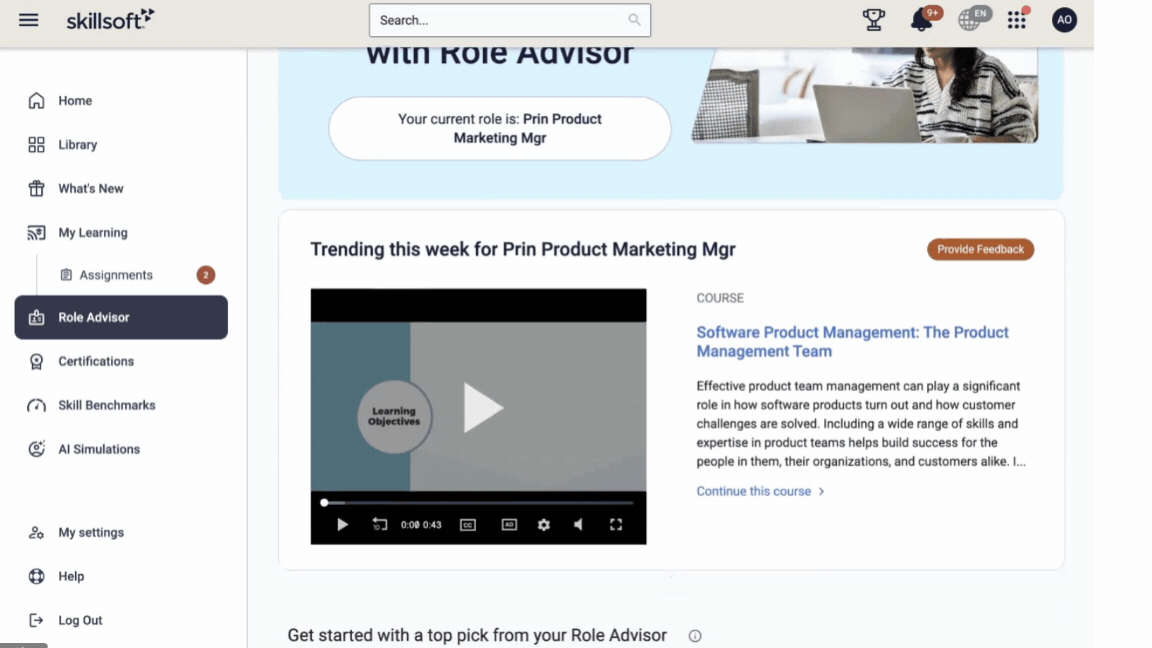Does Your LMS Integrate with Skillsoft?

Organizations that haven't adopted a skills taxonomy or ontology often struggle to assess the skills and capabilities of their workforce.
Today, talent development teams are under pressure to fill vacancies within their organizations to remain competitive and innovative. Many businesses have a skills gap that hinders their performance, manifesting in low-quality outcomes, attrition and the inability to drive meaningful change. Without a taxonomy, it's tough to plan for the future, properly resource initiatives, and close skill gaps.
A skills taxonomy helps standardize what skills are, their hierarchy and importance within the organization, and much more. This mechanism to organize skills helps bring the clarity that talent development teams need to support broader workforce transformation initiatives, especially as many transition from a role-based organization to a skills-based organization.
Here's how they're commonly used at work:
In many ways, a taxonomy provides the foundation for talent management operations. But given all the benefits of having a taxonomy, why are organizations still struggling to adopt one?
One study by Salary.com shows that more than half of HR professionals (54%) don’t know what a skills taxonomy or framework work is and 76% have yet to implement one.
There are reasons for this. It can be an arduous process to create one, or taking the alternative route, buying one, can pose challenges too. The solutions available on the market are often too simple, complex, or expensive.
In this blog, we'll explain the ins and outs of skill taxonomies, why they're helpful, and some challenges with using them.
Today, many businesses face challenges in identifying and categorizing employees' skills, aligning skill sets with organizational needs, and managing workforce development. In fact, the Salary.com report shows 86% of HR professionals haven’t inventoried or audited their workforce’s skills.
This isn’t necessarily a small undertaking, but solving these challenges can tremendously impact an organization's ability to attract and retain talent and stay competitive in the market. A skills taxonomy is a part of that solution.
Going without one, however, presents some challenges. Here are three that HR and talent development teams face when they don't use a taxonomy:
We will email when we make a new post in your interest area.
A skills taxonomy is a hierarchical framework that categorizes and organizes skills into groups and subgroups based on their relationships and similarities. It provides a structured way to identify, define, and measure skills within an organization. Unlike a skills ontology, which focuses on the connections between different skills, a skills taxonomy emphasizes the classification and hierarchy of skills.
Clarity in Skill Requirements
A skill taxonomy provides a clear and standardized definition of skills required for different roles. This clarity helps HR professionals as they recruit prospective job candidates, assess current employees for promotions and more. What’s more, most HR professionals (57%) believe having one helps decrease bias in job definitions, according to the Salary.com report.
Streamlined Learning Paths
Since skills are categorized neatly, it makes creating learning paths easier for learning and development professionals. Having insight into skills and the levels of proficiency, L&D professionals can more easily curate training, group resources, and deliver them to employees.
Effective Skill Assessment
A well-defined skills taxonomy allows talent development teams to assess employees' proficiency levels consistently and accurately. This assessment also helps identify skill gaps and tailor development programs to address those gaps effectively.
Enhanced Talent Management
By clearly understanding skill requirements and employee proficiency, talent development teams can make more informed decisions about promotions, role changes, succession planning, and more.
Talent development teams can create a skills taxonomy by identifying and categorizing the essential skills needed across various roles. They would then use this taxonomy to assess the workforce, identify gaps, and tailor training programs to address those needs.
Briefly, here's what it takes to develop a skills taxonomy:
This simplified version of the process leaves out many of the nuances involved in developing a taxonomy or ontology. It can get complicated. Just getting a meeting on every stakeholder's calendar to discuss this idea sounds impossible.
Nowadays, it's less common for organizations to build a skills taxonomy in-house. Talent development teams more often work with an outside consultant to help with some portion of the work or lean into the solutions provided by existing partners.
Many companies offer services or software solutions, either independently or as part of an ecosystem, to define and classify skills, gather and organize data, and then use this information to guide decision-making for professional development, career progression, and more. This includes Skillsoft, including our aforementioned Role Advisor feature in Percipio, which draws from an AI-generated taxonomy.
Skillsoft also integrates with many learning management systems, human capital management platforms, and similar vendors to tie skill taxonomies to training. One example is our integration with Workday, which offers its customers a skills ontology called the Skills Cloud. It uses machine learning to discover skills and capabilities, and then connect the people with said skills to training and jobs. Our integration makes Skillsoft training available in Workday, among other functions.
Several companies overlap in this area, with some more specialized than others, taking in data from various sources — social media, resumes, project management tools, and so on — to paint a detailed picture of what an individual employee is capable of. At a macro level, platform administrators can see the composition of their organization and understand how skills flow in and out of the business. This helps inform their next move, whether that's training or hiring or a combination of the two.
Some may encounter potential challenges whether pursuing this in-house or going with outside help. That's next.
Developing and implementing a skills taxonomy can present certain challenges despite the benefits.
For starters, creating a comprehensive skills taxonomy requires significant time and effort. It involves gathering input from various stakeholders and ensuring that the taxonomy accurately reflects the organization's needs. For this reason alone, many talent development teams opt to work with consultants or companies that provide a satisfactory taxonomy or ontology that they can use internally.
Whether developed in-house or outsourced, when a skills taxonomy is settled on, its value must be communicated to the workforce. In this case, change can be hard for some. Establishing new standards or processes in talent management will require communication and transparency, which will go a long way toward settling fears of skill obsolescence or devaluation.
Then, the team must update it over time. "As the company changes, as the marketplace changes, as the technology changes, as the products you offer change, we have to reskill people on a regular basis," said Josh Bersin, HR research analyst, in this podcast. "We're all in a world of continuous reskilling or upskilling, and sometimes we need a lot of new skills because the job we're in is going away... so what a skills ontology is intended to do is organize these skills into a hierarchy."
Ongoing evaluation and maintenance of your skills taxonomy keep it relevant, providing several benefits, like staying current on skill gaps, future business needs, and more.
A skills taxonomy provides a structured approach to managing skills, ensuring clarity, consistency, and efficiency in talent management processes. They also help organizations stay competitive and achieve their strategic goals by addressing skill gaps, streamlining learning paths, and enhancing talent management.
As we face the next era of technological change, continuous learning and development will be key to remaining adaptable. Leveraging a skills taxonomy can help organizations embrace this change, drive growth, and unlock human potential.
As your team strives to support its workforce through learning and development, see how Skillsoft can help.

Skillsoft Percipio uses an AI-generated skills taxonomy to create targeted learning paths. Percipio relies on AI/ML to map training to skills, and in doing so, learners get a personalized experience and find content that’s suited to their career aspirations. By using AI to complement ongoing assessments and activity in the platform, learners get clear direction on which training is best for them.
As learners onboard for the first time, they interact with our Role Advisor — a way to fully customize the platform to each individual’s preferences and interests. It also serves career-relevant training from the very start.
Naturally, this helps LMS admins who want to speed up content delivery and encourage learners to invest in themselves.
See how the platform personalizes learning by requesting a demo.

